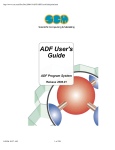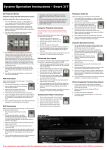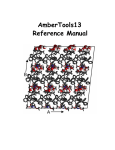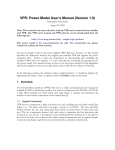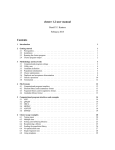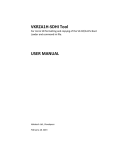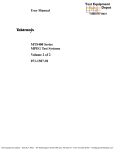Download User Manuals - Marcel Swart
Transcript
Quild Manual Quantum-regions Interconnected by Local Descriptions version 2009.01 Developed by: M. Swart, F. M. Bickelhaupt Amsterdam, 2004-2009 [email protected] [email protected] [email protected] Contents What’s new in the 2009.01 version ? p. 2 GUI-support, Symmetry within QUILD, More QM programs, Frequency calculations, Spin-contamination correction per region, Improved TS searches, Simplified and more detailed output, Improved primitive coordinates generation, Frozen coordinates versus constraints, Numerical gradients per region Basic philosophy p. 5 Multi-level energy expression p. 6 AddRemove method for capping atoms p. 9 Improved geometry optimization p. 10 Special cases p. 12 How to call the program External programs: MOPAC, ORCA, GENERIC p. 13 Input description Relevant keywords in QUILD block CONSTR subblock in QUILD block FROZEN subblock in QUILD block SYMROT subblock in QUILD block TSRC subblock in QUILD block REGION subblocks in QUILD block ADDREMOVE subblock in QUILD block DESCRIPTION subblocks in QUILD block Numerical versus analytical Hessians for multi-level vibrational frequencies Use of a GENERIC description for use with user-provided QM-program Spin-contamination correction per region INTERACTIONS subblock in QUILD block INLINE options in the QUILD block p. 14 p. 14 p. 15 p. 15 p. 15 p. 16 p. 16 p. 16 p. 17 p. 18 p. 18 p. 19 p. 20 p. 20 Example inputfiles Vibrational frequencies for multi-level QM/QM scheme Symmetry rotation with Td symmetry for geometry and C2v for orbitals Optimization with B3LYP through the post-SCF METAGGA scheme Optimization with B3LYP as SCF functional Geometry optimization with QM/MM treatment of water dimer LinearTransit run for bimolecular nucleophilic reaction of F– and CH3Cl Geometry optimization of pure spin state for spin-contaminated system LinearTransit run for water dimer p. 21 p. 21 p. 22 p. 23 p. 23 p. 24 p. 25 p. 26 p. 27 References p. 28 What’s new in the 2009.01 version GUI-support ADFinput has been adapted to provide full support for the multi-level setup in QUILD. See the ADF-GUI pages for more details. Symmetry within QUILD QUILD tries to use symmetry as much as possible, but only for the geometry; as such, more symmetries are possible than within ADF (for the orbitals). For instance, it enables the use of S4 symmetry for the geometry and C2 for the orbitals. Moreover, with the use of the SYMROT subblock (see p. 15) one can rotate coordinates from e.g. D5h to C2v for ferrocene. Therefore, this allows the separation of geometric and orbital symmetry. More QM programs Apart from ADF, NewMM and ORCA (for which an interface was already present), the new version includes interfaces to DFTB and MOPAC, and a GENERIC one to accommodate a generic QM program maintained by the user itself (see p. 18 for more details). The user-program only has to be able to transform the QUILD-generated coordinates into an energy/gradient etc. and return data in the format as specified (a simple text file). A working example for HONDO is available. Frequency calculations for QM, MM and multi-level QM/QM and QM/MM schemes Fully operational calculation of the Hessian in case of multi-level schemes, where for each description either an analytical or numerical setup can be chosen. This can be applied automatically for either QM calculations, MM calculations, or multi-level QM/MM or QM/QM calculations (including spin-contamination corrections). A full summary of the important thermodynamic properties (enthalpy at 0K and 298K, entropy, Gibbs free energy) is reported in the output, for instance: ###################################################################################################### S U M M A R Y O F E N E R G Y T E R M S ###################################################################################################### Pauli Repulsion: 1.234817178116662 33.6011 774.86 3242.01 Electrostatic Interactions: -0.238553103747176 -6.4914 -149.69 -626.32 Orbital Interactions: -1.496489120691529 -40.7215 -939.06 -3929.03 Quild Bonding Energy: -0.500224957131303 -13.6118 -313.90 -1313.34 -----------------------------------------------------------------------------------------------------Zero-Point Energy: 0.020896706726649 0.5686 13.11 54.86 Enthalpy H (0K): -0.479328250404654 -13.0432 -300.78 -1258.48 d(Enthalpy H) (0 => 298K): 0.002837412889686 0.0772 1.78 7.45 Enthalpy H (298K): -0.476490837514968 -12.9660 -299.00 -1251.03 -T*S (298K): -0.021452035100450 -0.5837 -13.46 -56.32 Gibbs-free-energy (298K): -0.497942872615418 -13.5497 -312.46 -1307.35 ###################################################################################################### 2 Spin-contamination correction per region The spin-contamination (S2) correction has been folded into the multi-level setup, which means the user can do a S2-correction for only one region. This option is now available for energy, gradients (optimizations, TSs) and Hessians (vibrational frequencies, numerical and analytical). See p. 19 for more details. Improved TransitionState (TS) search Simplification of initial Hessian generation, which makes it generally available for any elements of the Periodic Table. This should further enhance Transition State searches, which for Baker’s set of 25 TSs results in complete localization of all TSs within 343 cycles (i.e. 14 cycles per TS). Simplified and more detailed output The QUILD output has been drastically reduced (e.g. without the repetitive output of the Create runs in ADF), and at the same time more detail is given. At each optimization step, the progress of the optimization is reported: Geometry Optimization Progress ---------------------------------------------------------------------------------------------------Item Value Crit Convgd ---------------------------------------------------------------------------------------------------Gradient Max 0.052637 0.000100 NO Gradient RMS 0.011095 0.000100 NO Step Max 0.000000 0.000100 YES Step RMS 0.000000 0.000100 YES del(Energy) -168.585008 0.000010 NO # neg. Hesseig. 0 0 YES ---------------------------------------------------------------------------------------------------- and the components of the multi-level energy expression are explicitly mentioned: ======================================================================================================== hartree eV kcal/mol kJ/mol Energy terms for job 1 jobsign: 1 (MOPAC job, SCF energy) -------------------------------------------------------------------------------------------------------Pauli Repulsion: 0.000000000000 0.0000 0.00 0.00 Electrostatic Interactions: 0.000000000000 0.0000 0.00 0.00 Orbital Interactions: 0.000000000000 0.0000 0.00 0.00 Region Bonding Energy: -272.352918801950 -7411.1000 -170904.05 -715062.49 Energy terms for job 2 jobsign: 1 (ADF job, SCF energy) -------------------------------------------------------------------------------------------------------Pauli Repulsion: 65.846536707515 1791.7754 41319.33 172880.06 Electrostatic Interactions: -5.166530552507 -140.5884 -3242.05 -13564.72 Orbital Interactions: -66.098012956421 -1798.6184 -41477.13 -173540.31 Region Bonding Energy: -5.418006801413 -147.4315 -3399.85 -14224.97 Energy terms for job 3 jobsign: -1 (MOPAC job, SCF energy) -------------------------------------------------------------------------------------------------------Pauli Repulsion: 0.000000000000 0.0000 0.00 0.00 Electrostatic Interactions: 0.000000000000 0.0000 0.00 0.00 Orbital Interactions: 0.000000000000 0.0000 0.00 0.00 Region Bonding Energy: -109.185918021950 -2971.1000 -68515.21 -286667.59 -------------------------------------------------------------------------------------------------------Total (multi-level) QUILD energy -------------------------------------------------------------------------------------------------------Quild Bonding Energy: -168.585007581413 -4587.4315 -105788.70 -442619.87 ======================================================================================================== 3 Improved generation of primitive coordinates A new subroutine is used for generating the primitive coordinates, which should lead to less and more important coordinates (icreate 7). Frozen coordinates versus constraints A number of Cartesian coordinates can be kept frozen (with the FROZEN subblock, see p. 15), without the need to put additional constraints that may be sometimes awkward to put. This can be for instance be the case when the user wants to treat the active site of an enzyme and freeze certain atoms (e.g. the Cα atoms) to mimic the effect of the protein environment. Numerical gradients per region The numerical gradients that can be used within QUILD are now completely generalized, and can be specified per region. For instance, if one wants to use the numerical gradient of a hybrid-metagga functional (such as e.g. mPBE0KCIS) for a small part of the total system, and the analytical gradient of a GGA for the rest, it is simple and straightforward to achieve this: QUILD SMETAGGA mPBE0KCIS NR_REGIONS=2 INTERACTIONS TOTAL description 1 REPLACE region 1 description 3 for description 2 SUBEND REGION 1 1-3 SUBEND REGION 2 4-6 SUBEND DESCRIPTION 1 NEWMM ! MM input for NewMM, not explicitly shown here SUBEND DESCRIPTION 2 NEWMM ! MM input for NewMM, not explicitly shown here SUBEND DESCRIPTION 3 NUMGRAD MGGA BASIS type DZ core small END SCF Converge 1.0e-7 1.0e-7 Iterations 99 diis ok=0.01 END INTEGRATION 7.0 7.0 7.0 CHARGE 0.0 METAGGA SUBEND END 4 Basic philosophy The QUILD program1,2 has been developed for enabling calculations through multi-level approaches, in which different computational treatments are used for different regions of the system under study. The benefit of our multi-level approach is not only that it can be used to make the calculations cheaper and therefore feasible, but also that the best method for any type of interaction can be used as we need for DNA (vide infra). For describing DNA, we use one DFT functional for treating the complete system, and another for π-stacking between the DNA bases. This is achieved by making the definition of the regions flexible, i.e. there is no need to have a layered structure as in the ONIOM approach. An arbitrary splitting of the total system into different regions is permitted with, therefore, possibly overlapping regions; this resembles a quilt, hence the name of the program. The different treatments currently possible are based on either quantum mechanics (QM) or force field molecular mechanics (MM). The MM part is provided through the NEWMM program that is included within the ADF3,4 program package since the 2006.01 version. Density Functional Theory5-7 is provided by the ADF program, while an interface for the ORCA programi is available for inclusion of Hartree-Fock (RHF/UHF), Møller-Plesset (MP2) or semi-empirical (e.g. AM1, PM3) calculations. New in the 2009.01 version is the inclusion of DFTB (for Density Functional Tight Binding), Mopac (semi-empirical, e.g. PM6), and a generic (QM) program that allows the user to apply his/her own program. In all these cases, the other programs are used as black-box programs to deliver the energy and gradient, i.e., QUILD writes the inputfiles, runs the black-box programs, collect the data, makes new coordinates, and repeats this process until the geometry is optimized. The application of multi-level (QM/QM or QM/MM) approaches within computational chemistry studies is ever more often used, since it permits to use a highly accurate method for the most important region while treating the interactions with the surrounding regions at a lower, yet sufficiently accurate method. The QM/MM setup (see Figure to the left), where only the region of interest (region 1, in yellow) is treated with quantum chemistry methods while the interactions with and within the surrounding regions is described with classical molecular mechanics force fields, is the computationally most economical multi-level approach. Its accuracy and applicability depend largely on the accuracy and availability of force field parameters for the system under study. Specialized force fields are available for certain classes of chemical systems, such as the AMBER95 force field8 for proteins and nucleic acids, which is included within the ADF program package using the NEWMM program. However, the treatment of large biochemical systems containing thousands of atoms with QUILD is not to be advised due to the making of the adapted delocalized coordinates, involving a diagonalization step that is not feasible for systems with more than ca. 700 atoms (estimated). Treating large biochemical systems are best performed by the QM/MM scheme9-11 in ADF. Because of the computational efficiency, the availability of basis sets for the whole Periodic System, and the generally accurate results, Density Functional Theory (DFT) has become the method of choice for the majority of recent computational chemistry studies and can these days almost routinely be used for relatively large system sizes of up to hundreds of atoms (the largest system used with ADF in single-point calculations contained ca. 1200 atoms; the largest system used within geometry optimizations contained ca. 700 atoms).12-20 However, one must always remain cautious with the choice of DFT functional and/or basis set, and make sure that the particular functional is able to give a correct description for the interactions that are important for the system under study. For instance, the performance of functionals that include the recent OPTX exchange functional21 is superior to those containing Becke88 exchange,22 for instance for the accuracy of geometries,23,24 spin state splittings,25,26 reaction barriers23,27,28 or zero-point vibrational energies.23 As the improvements can be 3 5 1 5 linked directly to the specific formulation of the OPTX functional26,29 and its resulting improved 5 5 performance for atomic exchange energies,21 one would naively think that inclusion of the OPTX 5 2 4 5 functional would always lead to improved performance. Unfortunately, this is not the case for weakly bound systems, as shown recently for i Note that the ORCA program is not provided within the ADF program package, and the user (or system administrator) has to download and install the program him/herself. The ORCA program is free of charge for academic groups, more information can be found at http://www.thch.uni-bonn.de/tc/orca. 5 hydrogen-bonding30 and π-stacking31 in DNA. Moreover, a functional that performs well for hydrogen-bonding interactions (BP8622,32),30,33-37 does not necessarily give equally good results for π-stacking.31 As a result, at present there does not seem to be a DFT functional that is equally accurate for hydrogen-bonding, π-stacking and intramolecular interactions. Therefore, for a study on the structure of DNA duplexes, the multi-level QM/QM approach2 is needed with one DFT functional for the description of hydrogen-bonding interactions, and another for the description of π-stacking, which can be exploited within the QUILD scheme.2 In the Figure above, a schematic structure of DNA is presented with the bases (regions 1 to 4, in orange), and sugars and phosphate backbone (region 5, in cyan). Since BP86 works well for intramolecular interactions and hydrogen-bonding interactions, but not for π-stacking, BP86 is used for the whole system, and for the π-stacking its interactions are replaced by LDA. Multi-level energy expression Similar to the ONIOM approach,38,39 the total energy within the multi-level approach is obtained by combining the different energies, for instance, for the interactions in a protein depicted schematically below, with the active site (region 1, in yellow), the rest of the protein (region 2, in pink) and solvent (region 3, in blue). Suppose we want to treat the active site using a GGA functional in a large basis set, the rest of the protein by LDA in a small basis, and the solvent at MM level. The energy expression is then obtained by a sequence of 5 jobs: E = E MM (1,2,3) + E LDA (1,2) − E MM (1,2) + E GGA (1) − E LDA (1) First, the total system is described at the MM level (top-right), then the MM description for regions 1 and 2 is replaced by LDA (middle-right), and finally the LDA description for region 1 is replaced by the GGA description (bottom-right). € This splitting up of the total system into different jobs is fully automated, the user only has to assign the different regions and give descriptions for the QM and MM methods to be used. A second example of using a multi-level approach is posed by the application to DNA. In this case we do not want to replace all interactions within one region, but merely the interaction between two different regions. This is again achieved by a sequence of jobs, as indicated in the figure above on the right hand side. First, we have a 6 BP86 job for the whole system (top, in blue). Second, we add the LDA interaction energy for the left-side stacked basepair in a series of three jobs (middle, in yellow) and remove the corresponding BP86 interaction energy (middle, in blue). Third, we add the LDA interaction energy (bottom, in pink) and remove the corresponding BP86 interaction energy (bottom, in blue) for the right-side stacked basepair. The corresponding input for the second example would be schematically: QUILD NR_REGIONS 5 REGION 1 17-30 SUBEND REGION 2 77-91 SUBEND REGION 3 47-60 SUBEND REGION 4 111-122 SUBEND REGION 5 1-16 31-46 61-76 92-110 123-125 SUBEND DESCRIPTION 1 CHARGE -2 XC GGA Becke-Perdew END BASIS type TZ2P core SMALL END SUBEND DESCRIPTION 2 XC GGA Becke-Perdew END BASIS type TZ2P core SMALL END SUBEND DESCRIPTION 3 BASIS type TZ2P core SMALL END SUBEND INTERACTIONS TOTAL description 1 INTXN region 1 region 2 INTXN region 3 region 4 SUBEND description 3 for description 2 description 3 for description 2 END Next, we provide a line-by-line explanation of the above input: QUILD All input relevant for performing the QUILD job must be specified within a QUILD block. QUILD takes care of the remaining input that is needed in runs of ADF or other programs that are invoked (in a "black-box" manner) by QUILD. Exceptions are, for example, GEOMETRY, GEOVAR, etc., which are specified according to the ADF input syntax. Thus, detailed input parameters for the various programs that QUILD communicates with can be passed through to these programs via the QUILD input block (within DESCRIPTION subblocks, see below). Therefore, any option that is available in ADF (ZORA, COSMO, LDA, GGA, MGGA, HYBRIDS) or in the other programs (NEWMM, ORCA, DFTB, MOPAC, GENERIC) is also available in QUILD. 7 NR_REGIONS 5 The number of regions is set to five. The definition of the atoms that belong to each region is given in the REGION subblocks below: REGION 1 17-30 SUBEND REGION 2 77-91 SUBEND REGION 3 47-60 SUBEND REGION 4 111-122 SUBEND REGION 5 1-16 31-46 61-76 92-110 123-125 SUBEND In the above example, atoms 17 to 30 make up region 1 (an equivalent input would be to specify each atom number individually, i.e.: "17 18 19 20 21 22 23 24 25 26 27 28 29 30"), atoms 77 to 91 region 2, atoms 47 to 60 region 3, atoms 111 to 122 region 4, and the remaining atoms region 5. It is not necessary to define all regions explicitly: the first job (with the description as defined by the TOTAL line in the INTERACTIONS subblock) includes all atoms automatically. Only those regions which are explicitly used within the INTERACTIONS subblock need to be defined, i.e. in this case the definition of region 5 is not actually used. Note that the atom numbers are obtained by counting consecutively the atoms in the ATOMS block on input. DESCRIPTION 1 CHARGE -2 XC GGA Becke-Perdew END BASIS type TZ2P core SMALL END SUBEND DESCRIPTION 2 XC GGA Becke-Perdew END BASIS type TZ2P core SMALL END SUBEND DESCRIPTION 3 BASIS type TZ2P core SMALL END SUBEND Given here are the different descriptions that are needed for the BP86 and LDA treatments of the different regions. Note that there are two different descriptions using BP86, one (DESCRIPTION 1) for the complete system that has total charge -2, and a second one (DESCRIPTION 2) for the interaction between two stacked bases. For nonADF (i.e. NEWMM, ORCA, DFTB, MOPAC, or GENERIC) jobs, on the first line of the corresponding DESCRIPTION subblock it should say so, as given in the example below for description 4 (HF/STO-3G with ORCA): DESCRIPTION 4 ORCA ! other options for the program are ADF, DFTB, NEWMM, MOPAC, GENERIC %coords mult 2 charge -1 end %method method hf end %basis basis sto_3g end SUBEND 8 Note that in case of geometry optimizations where one of the jobs uses ORCA, the run-type (keyword runtyp) should be set to “gradient” in order that a “job*.engrad” file is written (by ORCA) that contains the ORCA energy and gradient. The QUILD program will automatically add this runtyp keyword to the corresponding input block. If the ORCA job deals with either an unrestricted job, or with a non-zero charge, it is best to put these data in the %coords block as shown above. Together with the general input (apart from ATOMS, GEOMETRY, etc. blocks that are automatically generated by the QUILD program) the contents of these DESCRIPTION subblocks will constitute the “blackbox” inputfile for the different programs. If there are differences in charge (vide supra), the charges of the total system and the regions should be given in these DESCRIPTION subblocks. Also when either the region is Unrestricted and the total system not (or vice versa), the description of being unrestricted (or not) should be given in the DESCRIPTION subblocks. Note that the general input contents is pasted only into input files for programs within the ADF program package, for external programs such as ORCA only the automatically generated atomic coordinates part and the part given in the DESCRIPTION subblock is put into the input file for the ORCA job. INTERACTIONS TOTAL description 1 INTXN region 1 region 2 INTXN region 3 region 4 SUBEND description 3 for description 2 description 3 for description 2 This is the subblock that determines how the multi-level job is setup. The total system will be treated by description 1, i.e. BP86 for all atoms. Then in the second line, the BP86 interaction between regions 1 and 2 is replaced by the corresponding LDA interaction. In the last line, the BP86 interaction between regions 3 and 4 is replaced by the LDA interaction. In total there are therefore 5 ADF jobs per geometry cycle. When the ADF program package is setup to run in parallel, and this is taken care of properly in the $ADFBIN/start script, then also within QUILD this is used. At present no attempt has been made yet to prepare the interface for the parallel version of ORCA, the user is responsible for installing the ORCA program (see also p. 13). AddRemove method40 for capping atoms Whenever the definition of a region splits through a covalent bond (or better put, whenever QUILD notices that there are dangling bonds within a certain job), it will automatically add capping atoms to satisfy the valence of the boundary atoms (see for instance Figure below). For the moment, the program automatically adds hydrogen as capping atoms, which in the future may be changed to include other elements as well, if needed. The capping atoms are added according to the AddRemove methodology,40 in which the capping atoms follow the position of the real atoms in the total system. I.e. the capping atoms are positioned along the vector of the dangling covalent bond, and at a distance that corresponds to the sum of the covalent radii of the capping atom and the atom to which the capping atom is attached. Because the capping atoms are added to the active site for both the high- and low-level QM calculation, with a presumably similar effect in both cases, the interactions of the capping atoms with the true active site atoms are in good approximation cancelled out (the total effect is removed) between the lower- and higher-level QM calculations. Within the AddRemove model, the energy and gradients are treated in similar fashion (unlike other models that project the gradients of the “artificial” capping atoms onto the gradients of the “real” atoms). The AddRemove model was previously40 shown to perform well for geometries around the boundary between the QM and MM region in QM/MM calculations. 9 In summary, the AddRemove model40 has several advantages: it is simple, the energy and gradients (and Hessian) are treated in similar fashion (unlike other models that for instance project the gradients of the capping atoms onto the gradients of the real atoms). Furthermore, the capping atoms follow the real atoms, at a predefined distance, and therefore no artificial degrees of freedom are added by including the capping atoms. In a strict sense, one could even argue that the replacement of the interactions of the capping atoms is performed consistently with the choices made for the multi-level approach. There is only one case where the use of the AddRemove model within the QUILD program is not straightforward, and that is posed by MM regions with dangling bonds (see Figure above, bottom right). The description of the MM region depends explicitly on a force field, that in turn needs for each atom in the MM region an atomtype that should be supplied by the user on input, together with all connection tables for all atoms. As the QUILD program automatically adds capping atoms (H cap in the Figure above), the DESCRIPTION subblock for the NEWMM description of the capped region (Figure above, bottom right) should include the atomtype and connections for the automatically added capping (hydrogen) atoms. The program checks for each job in a multi-level scheme, if they have atoms with dangling bonds. It does this by going over all regions that are included in that particular job; the order in which the regions are checked depends on how the regions are given on input (!). For instance, in the following line, region 2 is checked first and then region 1 as second: REPLACE region 2 region 1 description 3 for description 2 For checking the dangling bonds in each region, the program goes sequentially through all atoms and checks if they belong to that particular region; if so, and if the atom has a dangling bond (as the Cα atom has in the Figure above) a capping atom is added, which is positioned along this dangling bond. Improved geometry optimization One of the strong points of the QUILD program,1,2 apart from its flexible setup of the multi-level approach, is its enhanced geometry optimization capabilities. These result in part from the use of adapted delocalized coordinates,41 a modification of the original delocalized coordinates setup42 that enables the use on weak coordinates as well. Further enhancements are obtained through the use of regulated GDIIS,43,44 Restricted Second Order model (trust region),45,46 and a model Hessian.41 The latter includes the generation of a model Hessian for transition state searches by preparing the initial Hessian with the correct curvature and number of negative eigenvalues, which moreover correspond to the reaction coordinates (TSRC) for the transition state under study. The user has to specify on input what the relevant TSRC coordinates are, which will not only be used for the generation of the initial Hessian, but also to select the appropriate Hessian eigenvector when there are more (or less) than 1 negative Hessian eigenvalues. The details of setting up the delocalized coordinates, its adaptation to facilitate the use on weak and strong coordinates, and their characteristics can be found in refs. 41 and 2. Here we briefly mention the performance of the QUILD program for the Baker test set (a set with 30 organic molecules) and a test set with 18 weakly-bound molecules.2 For the Baker set, we need 167 iterations to fully converge all molecules to a gradient of 3.0·10-4 a.u. at RHF/STO-3G (results obtained using the interface to ORCA), and 164 at PW91/TZ2P. For comparison, the old-style optimizer in ADF using Cartesians needed 222 iterations. For the weakly-bound set, we need 175 iterations to fully optimize the molecules to a gradient of 1.0·10-5 a.u. at PW91/TZ2P. Again for comparison, the old-style optimizer in ADF using Cartesians needed 748 iterations. As an example, below is the relevant input for performing a transition state search for the bimolecular nucleophilic substitution reaction of fluoride on methyl chloride (see figure): Geometry TransitionState End QUILD TSRC dist 1 5 10 dist 1 6 SUBEND END ATOMS C H H H Cl F END Charge -1 0.000000 -0.530807 -0.530807 1.061614 0.000000 0.000000 0.000000 0.919384693 -0.919384693 0.000000 0.000000 0.000000 0.000000 0.112892 0.112892 0.112892 -2.124300 2.019100 INTEGRATION 6.0 6.0 SCF converge 1.0e-6 1.0e-6 diis ok=0.01 iterations 99 END The QUILD program will scan the input for the existence of a Geometry block (that indicates that QUILD should do an optimization), and will scan the Geometry block for the presence of the TransitionState keyword. If it is found, it will set the number of negative Hessian eigenvalues that are needed (nrnegneed) to 1, otherwise it will remain 0. The QUILD block should in this case contain a TSRC subblock where the coordinates involved in the transition state are given. In the example above, there are two TSRC coordinates, the C-Cl and the C-F bond, as indicated by the atom numbers. For the construction of the initial Hessian, a negative force constant is assigned to these coordinates. For instance in the outputfile, first the definition is given for the primitive coordinates as they are constructed by the QUILD program (with the TSRC coordinates shown below in blue): Number of MM coordinates (valence,intramol,intermol) : 32 ( 32, 0, 0) -------------------------------------------------------------------------------valence coordinates -------------------------------------------------------------------------------1 bnd 2 1 0 0 1 1.02076 2 bnd 3 1 0 0 1 1.02076 3 bnd 4 1 0 0 1 1.02076 4 bnd 5 1 0 0 1 0.50000 5 bnd 6 1 0 0 1 0.50000 6 ang 3 1 2 0 2 0.90892 7 ang 4 1 2 0 2 0.90892 etc. Further down in the output, the force constants for the different MM coordinates are shown (with the ones for the TSRC coordinates given in blue): Force Constants used: bnd bnd etc. 1 5 0.40831 -0.02804 bnd ang 2 6 0.40831 0.20839 bnd ang 3 7 0.40831 0.20839 bnd ang 4 8 -0.03252 0.20839 which are also coupled with each other: Off-diagonal TSRC Hessian-element : 5 4 -0.04271 -0.02804 -0.03252 And finally, the contributions of the TSRC coordinates to the Hessian eigenvalues is reported: Weight TSRC-coord Weight TSRC-coord 1 2 4 5 1.00000 Flindh 1.00000 Flindh 0.50000 0.50000 Contributions of TSRC coordinates to negative Hessian eigenvalue Contribution from primitive 5 0.49998 Bnd F 6 Contribution from primitive 4 0.49998 Bnd CL 5 Contribution from primitive 17 0.00001 Imp H 3 Contribution from primitive 15 0.00001 Imp H 4 Contribution from primitive 16 0.00001 Imp H 4 11 C C C C C 1 is 1 1 1 1 1 0.99996 H H H 4 2 3 H H H 2 3 2 Contributions of TSRC coordinates to all Hessian eigenvalues: Eigval 1 -0.07305 Contrib_All 0.99996 per_tsrc Eigval 2 0.01248 Contrib_All 0.93816 per_tsrc 0.49998 0.46908 0.49998 0.46908 As a result, the optimization converges within 10 cycles: QUILD summary for sn2_ts_orig.out Stp# Energy Gmax,adf Grms,adf Gmax,deloc. Grms,deloc. Symm #negH (kcal/mol) (a.u.) (a.u.) (a.u.) (a.u.) ======================================================================================================= 1 -620.9561 0.007101756 0.003028991 0.011855992 0.003715738 C(3V) 1 2 -620.8929 0.023635611 0.007391899 0.013690739 0.005638699 C(3V) 1 3 -621.2068 0.016710875 0.005351311 0.026217447 0.007807519 C(3V) 1 4 -620.8176 0.004699225 0.001709580 0.011879183 0.003484516 C(3V) 1 5 -620.3782 0.008811234 0.002829390 0.018504386 0.005671159 C(3V) 1 6 -620.8564 0.001689444 0.000533251 0.002432001 0.001015262 C(3V) 1 7 -620.9381 0.002213820 0.000584005 0.000987755 0.000448095 C(3V) 1 8 -620.8942 0.000576597 0.000161025 0.000424960 0.000141833 C(3V) 1 9 -620.8840 0.000112994 0.000037557 0.000241219 0.000074629 C(3V) 1 10 -620.8831 0.000010191 0.000003368 0.000021158 0.000006610 C(3V) 1 +++++++++++++++++++++++++++++++++++++++++++++++++++++++++++++++++++++++++++++++++++++++++++++++++ Geometry CONVERGED !!! Energy at optimized geometry : -620.8831 (kcal/mol) +++++++++++++++++++++++++++++++++++++++++++++++++++++++++++++++++++++++++++++++++++++++++++++++++ Additionally, the QUILD optimizer allows to constrain bonds, angles or dihedrals during the optimization, in which it uses the method by Baker.47 This method has the nice feature that the constraints do not have to be met in the initial geometry, but are enforced through the use of Lagrangian multipliers. The ability of adding constraints has been extended to perform a LinearTransit, i.e. a series of constrained optimizations, that can be used to scan a potential energy surface as function of e.g. a bond. For the SN2 reaction shown above, the relevant input to do a LinearTransit would be: QUILD nrlt 11 CONSTR dist 1 6 2.5 1.5 SUBEND END This means that the C-F distance is reduced (while constrained) in 11 steps, starting from 2.5 Å and going to 1.5 Å, in steps of 0.1 Å. All other coordinates are free to optimize in this example, however a combination of more than one constrained coordinates is possible; either by including them also as LT coordinate, or simply as constraint. Special cases Because the QUILD program serves as a wrapper around the ADF, NEWMM and ORCA programs, it has additional capabilities that may not be present within these programs themselves. A numerical evaluation of the energy gradients in QUILD enables the use of geometry optimization techniques for any methodology within either of these programs, also for those for which only the energy expression is known or implemented (for instance meta-GGA or hybrid functionals, Spin-Orbit ZORA, or excited states within ADF) and for which geometry optimizations are otherwise out of reach (see for example ref. 27 for geometry optimizations with metaGGA functionals, and ref. 2 for optimizations of excited state and spin-orbit geometries). It should be noted that because of the numerical evaluation of the gradients, requiring 6N+1 energy calculations per geometry step (with N the number of atoms), these calculations do require a significantly larger CPU-time. A second additional capability is the possibility to perform a geometry optimization for the pure spin states in systems that suffer from spin contamination. The spin contamination is simply projected out, not only for the energy but also for the gradient (and Hessian), by performing two consecutive jobs, one for the contaminated spin state, a second with the multiplicity increased (that is mixed in into the contaminated job). For instance, the following example gives an example input: QUILD INTERACTIONS TOTAL description 1 S2CORR description 2 SUBEND 12 DESCRIPTION 1 CHARGE 0.0 1.0 Unrestricted SUBEND DESCRIPTION 2 CHARGE 0.0 3.0 Unrestricted SUBEND END See ref. 25 for an example of using this setup on a spin-contaminated system. How to call the program The QUILD program is available in the general 2009.01 release of ADF, and should be called in similar fashion as ADF, e.g. #! /bin/sh $ADFBIN/quild << eor ! Normal ADF input, maybe extended with a QUILD inputblock (see below) eor The user is responsible for the installation of external programs such as ORCA, MOPAC or a GENERIC program. For the use of ORCA, the user should make sure that the following works: orca quildjob.1.inp and gives the corresponding quildjob.1.engrad file. For the use with MOPAC the 2009 version of Mopac is needed (see http://openmopac.net), and SCM_MOPAC should be set to the location where MOPAC is installed. The first line of the MOPAC subblock should contain the AUX(0) directive, as in the following example: DESCRIPTION 3 MOPAC AUX(0) BONDS CHARGE=0 SCFCRT=1.0D-8 PM3 1SCF GRAD Coordinates generated by ADFinput (c) SCM 1998-2008 SUBEND Finally, note that the MOPAC subblock should contain 2 lines ! For the use of QUILD with a GENERIC program, the input is straightforward: DESCRIPTION 3 GENERIC ! Here the specific input for the user-provided GENERIC program SUBEND It should be noted that by default, QUILD will use $ADFBIN/quild_generic as script for use with the GENERIC subblock (this example script facilitates the use of HONDO). However, this can be overridden by setting the environment variable $QUILD_GENERIC to a user-provided script (see also p. 18). 13 Input description Relevant keywords in QUILD block name CVG_ENR CVG_GRD default 1.0e-5 1.0e-4 CVG_STP DIFSTEP I_ADD_DUMMIES 1.0e-4 1.0e-5 1 ICREATE IDCVG 7 1 IDELOCAL 1 IDIIS 3 IDSTEP 5 IEXCST 1 IHOPT 3 IHUPD -1 cq. 4 IQUILD_OUTPUT IRESTART 1 0 ITRUST MXDIIS MXGEO 0 5 50 NR_REGIONS NRLT RTRUST SMETAGGA 1 0 0.20 - SYMGEO TRUST_ALFA TRUST_BETA TRUST_GOOD TRUST_RMIN 1.20 0.70 0.80 0.40 description Convergence criterium for energy (when IDCVG >= 2) Convergence criterium for maximum component of gradient; depending on the value of IDELOCAL, either the delocalized or Cartesian gradient is checked Convergence criterium for maximum component of step (when IDCVG >= 2) Stepsize for numerical differentiation (with numerical gradients/Hessian) Index to do (1) or do not (0) add dummy atoms for avoiding (nearly-)linear angles Index which method to use for generating the primitive coordinates Index how to signal convergence: 1) check nr. of negative Hessian eigenvalues is correct and max. component and rms value of gradient are less than the convergence criterium (see CVG_GRD) 3) same as 1, but both max. component of step and change in energy should be less than their respective convergence criteria (see CVG_STP and CVG_ENR) 2) same as 3, but only of the additional criteria has to be fulfilled Kind of coordinates to use in the geometry optimization: 1) adapted delocalized coordinates 0) Cartesian coordinates Kind of GDIIS equations to use: 0) original GDIIS 1) same as 0, but with Farkas-Schlegel rules applied 2) use gradient as error vector 3) same as 2, but with Farkas-Schlegel rules applied 4) use “energy” vector as error vector 5) same as 4, but with Farkas-Schlegel rules applied Step to take: 1) RSO for minimizations, RFO (Baker) for TransitionStates 3) RFO (Baker) always 5) Generalized RSO (Swart) using image-function for TransitionStates Number of excited state to use for numerical gradients By default for singlet excited state; triplet excited state can be used by adding ONLYTRIP keyword to EXCITATIONS block on input Index for force constants method to use for initial Hessian: 0) Baker (0.5 bonds, 0.2 angles, 0.1 dihedrals) 1) Thomas Fischer 2) simplification of Lindh 3) Swart-Bickelhaupt scheme 7) Swart generalized scheme (works well for close to minima) Index for Hessian update scheme: 1 BFGS for Hessian (-1 BFGS for inverse Hessian) 2 Powell-symmetric-Broyden, PSB (for Transition States) 3 Murtagh-Sargent (Symmetric Rank-One, SR1) 4 Bofill weighted combi of PSB and SR1 (for Transition State) 5 Farkas-Schlegel weighted combi of BFGS and SR1 6 Bakken-Halgaker combi of BFGS and SR1 Amount of output requested, debug output >=2 Index if ADF/ORCA jobs should restart from t21.files from previous geometry cycles <0 ORCA uses restart, ADF not >0 both ORCA and ADF use restart Index if dynamic trust radius should be used (1) or not (0) Maximum number of GDIIS vectors to use Maximum number of geometry cycles (overrides value read from ITERATIONS in GEOMETRY block) Number of different regions for multi-level approach Number of LinearTransit steps Trust radius value String for functional from METAGGA post-SCF scheme to use for numerical gradients, should be given exactly as on METAGGA output Symmetry to be used within QUILD (default is highest possible) Factor to increase trust radius if ∆energy agrees with model prediction Factor to decrease trust radius if ∆energy does not agree with model Lower threshold for increasing trust radius Upper threshold for decreasing trust radius The other keywords that are printed in the output are for debug purposes, under development, or of technical nature. More information about them can be obtained (if needed) from SCM or M. Swart. 14 CONSTR subblock in QUILD block Constraints can be supplied in the CONSTR subblock of QUILD. Below are the different option that are possible: QUILD CONSTR dist angle dihed x y z SUBEND END 1 2 1 2 3 1 2 3 4 1 1 1 0.9 120.0 100.0 0.0 0.0 0.0 ! only with idelocal=0 ! only with idelocal=0 ! only with idelocal=0 The units of these constraints are determined by the parameters in the UNITS block. The numbers in this subblock refer like usual to the atom numbers, as they are found in the ATOMS block. A special case is observed for LinearTransit calculations, as given in the example below. QUILD nrlt 11 CONSTR dist angle SUBEND END 1 2 1 2 3 1.0 120.0 2.0 70.0 Here there are two LinearTransit coordinates, i.e. the distance between atoms 1 and 2 and the angle 1-2-3. The distance between atoms 1 and 4 is a simple constraint throughout the whole calculation. FROZEN subblock in QUILD block Another way to introduce constraints is by freezing certain atoms. This can be achieved with the FROZEN subblock of QUILD, where either all three Cartesian (x, y, z) coordinates of an atom (or a series of atoms) can be frozen, or only one of the three: QUILD FROZEN x xyz SUBEND END 1-37 48-256 ! the X-coordinates of atoms 1 to 37 are kept frozen ! the X,Y,Z-coordinates of atoms 48 to 256 are kept frozen SYMROT subblock in QUILD block Sometimes, one wants to lower the symmetry because of more convenient descriptions of d-orbitals of transition metals for instance. In that case, if one still wants to maintain the higher symmetry for the geometry, one can use the SYMROT subblock to rotate the coordinates. For instance, for Fe(II)(Cl)42- with Td geometric symmetry, the Fe d-orbitals are not conveniently separated. This might be better done within C2v symmetry: Symmetry C(2v) QUILD Symgeo T(d) Symrot -0.7071067811865475 -0.7071067811865475 -0.7071067811865475 0.7071067811865475 0.0 0.0 Subend End Atoms Fe Cl Cl Cl Cl End 0.000000000 -1.326583289 -1.326583289 1.326583289 1.326583289 0.0 0.0 1.0 0.000000000 1.326583289 -1.326583289 1.326583289 -1.326583289 0.000000000 1.326583289 -1.326583289 -1.326583289 1.326583289 15 This transforms the coordinates from Td symmetry: Atomic coordinates atom nr x (Bohrs) y (Bohrs) z (Bohrs) x (angs) y (angs) z (angs) -------------------------------------------------------------------------------------------FE 1 0.00000 0.00000 0.00000 0.00000 0.00000 0.00000 CL 2 -2.50688 2.50688 2.50688 -1.32658 1.32658 1.32658 CL 3 -2.50688 -2.50688 -2.50688 -1.32658 -1.32658 -1.32658 CL 4 2.50688 2.50688 -2.50688 1.32658 1.32658 -1.32658 CL 5 2.50688 -2.50688 2.50688 1.32658 -1.32658 1.32658 to C2v symmetry: SYMMETRY C(2V) Atoms FE CL CL CL CL End 0.000000000 0.000000000 1.876072079 -1.876072079 0.000000000 0.000000000 1.876072079 0.000000000 0.000000000 -1.876072079 0.000000000 1.326583289 -1.326583289 -1.326583289 1.326583289 The particular rotation matrix to be used depends on the choice made by the user for how to represent the molecule in the lower symmetry (see ADFinput how to impose symmetry). TSRC subblock in QUILD block The Transition State Reaction Coordinates that are used to construct the special initial Hessian, should be given in the TSRC subblock of QUILD. Similar to the CONSTR subblock, the distances, angles, or dihedrals should be specified, one per line, with atom numbers. The atom numbers should refer to the atoms as they are found in the ATOMS block. QUILD TSRC dist angle dihed SUBEND END 1 2 1 2 3 1 2 3 4 REGION subblocks in QUILD block The definition of the different regions should be given in REGION subblocks of QUILD. Although the program counts the number of regions itself, it should be regarded good practice to make sure that the NR_REGIONS keyword corresponds to the correct number of REGION subblocks. QUILD NR_REGIONS 2 REGION 1 1-11 SUBEND REGION 2 12 14 13 15 16 17 19 18 22 21 20 SUBEND END The order in which the atom numbers are given does not matter, and in order that the input is easier to make and read, shortcuts are introduced. For instance, the “1-11” shortcut corresponds to “1 2 3 4 5 6 7 8 9 10 11”, etc. Unlike other multi-level approaches, there is no need to have a shell structure for the different regions. I.e., the regions can overlap, or be defined as given above for DNA. ADDREMOVE subblock in QUILD block There is no ADDREMOVE subblock of QUILD active yet, but in the future it will be added to be able to control how the capping atoms will be added in the case of regions with dangling bonds. I.e., which elements should be added, and so on. For the moment, only hydrogens will be added, which works without problems for QM/QM and/or QM/MM calculations on DNA, or simple peptides. Future developments should decide whether this needs to be adapted. 16 DESCRIPTION subblocks in QUILD block In case of multi-level jobs, where different regions are treated with different methodologies, the different methodologies should be given in the DESCRIPTION subblocks. QUILD DESCRIPTION 1 ADF [NUMFREQ] XC GGA OPBE END BASIS type TZ2P core NONE END SUBEND DESCRIPTION 2 ADF NUMGRAD XC HYBRID B3LYP SUBEND basis type DZ core NONE end SUBEND DESCRIPTION 3 ORCA NUMFREQ %method method hf runtyp gradient end %basis basis sto_3g end %coords mult 2 charge -1 end SUBEND DESCRIPTION 4 NEWMM NUMFREQ QMMM FORCE_FIELD_FILE $ADFRESOURCES/ForceFields/amber95.ff QMMM_INFO -1 OW QM -0.8340 HOH 1 O 2 3 2 HW QM 0.4170 HOH 1 H1 -1 3 HW QM 0.4170 HOH 1 H2 -1 4 OW MM -0.8340 HOH 2 O 5 6 5 HW MM 0.4170 HOH 2 H1 4 6 HW MM 0.4170 HOH 2 H2 4 SUBEND END SUBEND DESCRIPTION 5 DFTB NUMFREQ CHARGE 0 GEOMETRY runtype SP iterations 1 END 1 SUBEND DESCRIPTION 6 MOPAC NUMFREQ AUX(0) BONDS CHARGE=0 SCFCRT=1.0D-8 PM3 1SCF GRAD Coordinates generated by ADFinput (c) SCM 1998-2009 SUBEND DESCRIPTION 7 GENERIC NUMGRAD NUMFREQ ! input-description specific for GENERIC program for the system under study (see above) SUBEND END Description 1 here applies to OPBE/TZ2P(ae) with ADF, description 2 to B3LYP/DZ(ae) with ADF, description 3 to UHF/STO-3G through the ORCA interface,i and finally descriptions 4 to 7 apply to description for NEWMM, DFTB, MOPAC and GENERIC respectively. i Note that the ORCA program is not provided within the ADF program package, and the user (or system administrator) has to download and install the program him/herself. The ORCA program is free of charge for academic groups, more information can be found at http://www.thch.uni-bonn.de/tc/orca. 17 The input for multi-level approaches has been explained above, at p. 7-8. The standard input should be given for ADF, DFTB and NEWMM. See the corresponding User Manuals for ADF, DFTB and ADF-QM/MM respectively for them. Also for ORCA should standard input be used, the only exception being the total charge and multiplicity, which should be given as a partial %coords block. The QUILD program will then add the atomic coordinates to this block for the “black-box” inputfiles. Numerical versus analytical Hessians for multi-level vibrational frequencies The descriptions on the previous page indicate for some of the programs, whether the gradients and Hessians can be obtained analytically (no extra keywords necessary) or numerically. In the latter case, depending on if it is for the gradients or Hessian, one should add NUMGRAD or NUMFREQ to the DESCRIPTION line (see previous page). The QUILD program will then take care of preparing the correct number of jobs etc. Use of a GENERIC description for use with user-provided QM-program The 2009.01 version of QUILD allows the user to create his/her own script for use with a QM-program (e.g. HONDO, Molcas, etc.) for which no standard interface is available yet within QUILD. For this purpose (and with the GENERIC description above), the QUILD program writes a generalized inputfile for this script that consists of the following: Line 1: NAT IQRUN NAT number of atoms IQRUN type of job: 0 single-point energy 1 single-point energy+grad 2 single-point energy+grad+Hess Line 2 to NAT+1 ATOM X Y Z ATOM atomname X Cartesian X-coordinate (in Å) Y Cartesian Y-coordinate (in Å) Z Cartesian Z-coordinate (in Å) Remaining lines User provided lines on input (within DESCRIPTION block) The user should then make sure that his/her script runs their program, and extract data from it in the following manner (the QUILD program reads these lines as free format, e.g. spaces or upper/lowercase are not important): # ---------------------------------------------# lines starting with # will be ignored by QUILD # ---------------------------------------------# --------------# number of atoms # --------------[nat] 3 # ---------------------# total energy (Hartree) # ---------------------[energy] -74.964263362500 # ---------------------------# cartesian coordinates (Bohr) # ---------------------------[xyz] 0.0000000 0.0000000 0.0000000 [xyz] 0.0000000 -1.4572640 -1.1166010 [xyz] 0.0000000 1.4572640 -1.1166010 # -------------------# expectation value S2 # -------------------[s2] 0.000000000000 [sz] 0.000000000000 # -----------------------------# energy gradient (Hartree/Bohr) # -----------------------------[grad] 0.0000000 0.0000000 -0.0424023 [grad] 0.0000000 0.0073465 0.0212011 [grad] 0.0000000 -0.0073465 0.0212011 # -----------------------------# Hessian matrix (Hartree/Bohr2) # ------------------------------ 18 [hess] [hess] [hess] [hess] [hess] [hess] [hess] [hess] [hess] [hess] [hess] [hess] [hess] [hess] -0.03797442 0.01898721 0.00000000 0.00000000 0.00000000 -0.01201427 0.00000000 0.00000000 0.00000000 0.01898721 -0.01201427 0.00000000 0.00000000 0.00000000 0.00000000 0.00000000 -0.46505603 0.00000000 0.24554704 0.00000000 -0.46505603 -0.02685307 0.30821802 0.00000000 0.00000000 -0.02685307 0.37088899 -0.30821802 0.00000000 0.00000000 -0.37088899 0.62917145 -0.31458572 0.00000000 -0.24554704 -0.06267097 0.29686554 0.00000000 0.00000000 0.06267097 -0.31458572 0.29686554 0.01898721 0.00000000 0.00000000 0.00000000 0.01898721 -0.00697295 0.00000000 0.00000000 0.00000000 -0.00697295 0.00000000 0.00000000 0.00000000 0.00000000 0.93011207 -0.46505603 -0.24554704 0.00000000 0.00000000 0.49190911 -0.37088899 0.06267097 0.00000000 -0.46505603 0.49190911 -0.06267097 0.00000000 0.00000000 0.37088899 -0.31458572 0.00000000 0.00000000 0.30821802 -0.31458572 0.01772018 0.00000000 0.24554704 -0.30821802 0.01772018 # -----------------------------------------------------# example of data for S2-correction # in this case the Sz and S2 values should also be given # -----------------------------------------------------# --------------# number of atoms # --------------[nat] 2 # ---------------------# total energy (Hartree) # ---------------------[energy] -74.362823992381 # ---------------------------# cartesian coordinates (Bohr) # ---------------------------[xyz] 0.0000000 0.0000000 0.0000000 [xyz] 0.0000000 1.4572640 -1.1166010 # -------------------# expectation value S2 # -------------------[s2] 0.753292786229 [sz] 0.500000000000 Spin-contamination correction per region Previously, the spin-contamination correction was done for the complete system, but starting from version 2009.01 it can be performed for different regions, as in the following example: QUILD DESCRIPTION 1 ADF Occupations smearq=0.0 & AA1 4.0 // AA2 0.0 // EE1 8.0 // EE2 6.0 // AAA1 0.0 // AAA2 4.0 // EEE1 6.0 // EEE2 4.0 // End CHARGE 0.0 1.0 Unrestricted SUBEND DESCRIPTION 2 ADF Occupations smearq=0.0 & AA1 5.0 // AA2 0.0 // EE1 8.0 // EE2 6.0 // AAA1 0.0 // AAA2 4.0 // EEE1 6.0 // EEE2 4.0 // End CHARGE 0.0 3.0 Unrestricted SUBEND 5.0 0.0 8.0 4.0 0.0 4.0 6.0 4.0 4.0 0.0 8.0 4.0 0.0 4.0 6.0 4.0 19 INTERACTIONS TOTAL description 1 S2CORR region 1 spin-splus-description 2 for contaminated-description 1 SUBEND END SYMMETRY D(5H) Note that this in this case, the spin-contaminated system (doublet) consists of a triplet-alfa in the EE2-irrep coupled with a doublet-beta in the AA1-irrep. This is corrected for by a pure quartet, and the corresponding energies corrected: Values for S2correction 1 : s2cont 1.75396 s2pure 0.75000 s2plus 3.78716 a_s2 0.33056 jobsigns job 2 -0.49378 job 1 1.49378 INTERACTIONS subblock in QUILD block One of the most important input-parts for multi-level jobs is the INTERACTIONS subblock of QUILD, where one should define how the different descriptions should be applied to the different regions. At the part where we explained the multi-level approaches, we already showed some examples of how to combine different methodologies. Below is another example input where all possible options are given. QUILD INTERACTIONS TOTAL description 1 REPLACE region 1 region 2 description REPLACE region 1 description INTXN region 1 region 2 description S2CORR region 1 spin-splus-description SUBEND END 3 4 3 2 for for for for description 2 description 3 description 2 contaminated-description 1 If an INTERACTIONS subblock is present (if none is present it means no multi-level setup is done, i.e. pure QM or MM), there should always be a line with the description of the total system, as shown in the first line of the INTERACTIONS subblock. Then if you want to replace the interactions for one (or more) region(s), you could do so as indicated in the second and third line. Finally, if you want to replace the interaction between two regions, as we need for DNA where we replace the BP86 π-stacking by LDA π-stacking, the fourth line of the INTERACTIONS subblock should be used. Finally, the last line can be used for spin-contamination corrections for one (or more) regions. Note that in all cases it is not necessary at all to add the “region”, “description” and “for” words in the INTERACTIONS subblock; they are ignored when reading the input. The program reads the line, uses the last two integers for the descriptions and the ones before for the regions. Therefore, a completely equivalent input would be as shown below. However, for better readability, it is to be advised to always use the additional text anyway. QUILD INTERACTIONS TOTAL REPLACE 1 2 REPLACE 1 INTXN 1 2 S2CORR 1 S2CORR 1 3 SUBEND END 3 4 3 2 2 1 2 3 2 1 1 Note that in the last line, it is indicated that the spin-contamination correction is applied to regions 1 and 3 together. INLINE options in the QUILD block Similar to the situation in ADF, one can use the INLINE directive to read specific input-lines from a file rather than from input. In general, this should make no difference, but in rare instances (for instance if the $ sign is needed in inputfiles for one of the programs), it might become useful. 20 Example inputfiles (a set with many more examples is provided in the $ADFHOME/examples/quild directory) Vibrational frequencies for multi-level QM/QM scheme $ADFBIN/quild << eor ATOMS C -0.759255999 C 0.759255999 H -1.179949313 H -1.179949313 H -1.115011042 H 1.179949313 H 1.179949313 H 1.115011042 END 0.032048841 -0.032048841 -0.464915468 -0.464915468 1.076188400 0.464915468 0.464915468 -1.076188400 0.000000000 0.000000000 0.890460461 -0.890460461 0.000000000 0.890460461 -0.890460461 0.000000000 GEOMETRY Frequencies END AnalyticalFreq End Integration 7.0 7.0 SCF converge 1.0e-7 1.0e-7 diis ok=0.01 END QUILD NR_REGIONS=2 REGION 1 1-8 SUBEND REGION 2 2 6-8 SUBEND DESCRIPTION 1 ADF BASIS type DZ core Large END SUBEND DESCRIPTION 2 ADF ! adding NUMFREQ would use numerical Hessian (not necessary in this case, ! because Analytical Hessian is available) BASIS type TZP core Large END SUBEND INTERACTIONS TOTAL description 1 REPLACE region 2 description 2 for description 1 SUBEND END END INPUT eor rm quildjob* 21 Symmetry rotation with Td symmetry for geometry and C2v for orbitals $ADFBIN/quild << eor Title JCTC systems Occupations smearq=0.0 & A1 10.0 A2 3.0 B1 6.0 B2 6.0 End // // // // 9.0 2.0 5.0 5.0 Symmetry C(2v) QUILD Symgeo T(d) Symrot -0.7071067811865475 -0.7071067811865475 0.0 -0.7071067811865475 0.7071067811865475 0.0 0.0 0.0 1.0 Subend End Atoms Fe Cl Cl Cl Cl End 0.000000000 -1.326583289 -1.326583289 1.326583289 1.326583289 0.000000000 1.326583289 -1.326583289 1.326583289 -1.326583289 0.000000000 1.326583289 -1.326583289 -1.326583289 1.326583289 Geometry End Charge -2 4 Unrestricted XC LDA VWN GGA OPBE END BASIS type TZ2P core SMALL END SCF converge 1.0e-6 1.0e-6 iterations 99 diis ok=0.01 END INTEGRATION 6.0 6.0 EPRINT SFO noeig noovl END endinput eor 22 Optimization with B3LYP through the post-SCF METAGGA scheme $ADFBIN/quild << eor title Geometry optimization EPRINT SFO NOEIG NOOVL END XC GGA BLYP END ATOMS O .000000 .000000 C .000000 .000000 END BASIS type DZ core NONE END GEOMETRY END SCF diis ok=0.01 converge 1.0e-5 1.0e-5 END QUILD cvg_grd 1.0e-4 numgrad 1 SMETAGGA B3LYP(VWN5) END METAGGA HFEXCHANGE INTEGRATION 5.0 5.0 endinput eor .000000 1.128100 Optimization with B3LYP as SCF functional $ADFBIN/quild << eor title Geometry optimization EPRINT SFO NOEIG NOOVL END XC HYBRID B3LYP END ATOMS O .000000 .000000 C .000000 .000000 END BASIS type DZ core NONE END GEOMETRY END SCF diis ok=0.01 converge 1.0e-5 1.0e-5 END QUILD cvg_grd 1.0e-4 numgrad 2 END INTEGRATION 5.0 5.0 endinput eor .000000 1.128100 23 Geometry optimization with QM/MM treatment of water dimer $ADFBIN/quild << eor TITLE QM/MM calculation setup by pdb2adf: M.Swart, 2005 GEOMETRY END ATOMS O 0.0000 H -0.5220 H -0.5220 O 0.0000 H 0.0570 H 0.9110 END 0.0000 0.2660 0.2660 -3.2000 -2.2440 -3.4950 0.0000 -0.7570 0.7570 0.0000 0.0000 0.0000 QUILD NR_REGIONS=2 INTERACTIONS TOTAL description 1 REPLACE region 1 description 3 for description 2 SUBEND REGION 1 1-3 SUBEND REGION 2 4-6 SUBEND DESCRIPTION 1 NEWMM QMMM FORCE_FIELD_FILE $ADFRESOURCES/ForceFields/amber95.ff MM_CONNECTION_TABLE 1 OW QM 2 3 2 HW QM 1 3 HW QM 1 4 OW MM 5 6 5 HW MM 4 6 HW MM 4 SUBEND CHARGES 1 -0.8340 2 0.4170 3 0.4170 4 -0.8340 5 0.4170 6 0.4170 SUBEND END SUBEND DESCRIPTION 2 NEWMM QMMM FORCE_FIELD_FILE $ADFRESOURCES/ForceFields/amber95.ff MM_CONNECTION_TABLE 1 OW QM 2 3 2 HW QM 1 3 HW QM 1 SUBEND CHARGES 1 -0.8340 2 0.4170 3 0.4170 SUBEND END SUBEND DESCRIPTION 3 EPRINT SFO NOEIG NOOVL END XC 24 GGA Becke-Perdew END BASIS type TZP core small END SCF Converge 1.0e-5 1.0e-5 Iterations 99 END INTEGRATION 5.0 5.0 5.0 CHARGE 0.0 SUBEND END ENDINPUT eor LinearTransit run for bimolecular nucleophilic reaction of F– and CH3Cl $ADFBIN/quild << eor Title LinearTransit for Sn2 reaction of F- + CH3Cl XC GGA OPBE END QUILD nrlt 11 cvg_grd 1.0e-4 CONSTR dist 1 6 2.5 1.5 SUBEND END ATOMS C H H H Cl F END 0.000000 -0.530807 -0.530807 1.061614 0.000000 0.000000 0.000000 0.000000 0.919384693 0.112892 -0.919384693 0.112892 0.000000 0.112892 0.000000 -1.724300 0.000000 2.500000 Geometry End BASIS type TZ2P core NONE END INTEGRATION 6.0 6.0 SCF converge 1.0e-6 1.0e-6 diis ok=0.01 iterations 99 END Charge -1 EPRINT SFO noeig noovl END endinput eor 25 Geometry optimization of pure spin state for spin-contaminated system $ADFBIN/quild << eor Title InorgChimActa paper EPRINT SFO NOEIG NOOVL END XC GGA OPBE END GEOMETRY END BASIS type TZP core SMALL END SCF Iterations 99 Diis ok=0.01 Mix 0.1 converge 1.0e-6 1.0e-6 END INTEGRATION 6.0 6.0 6.0 QUILD INTERACTIONS TOTAL description 1 S2CORR description 2 SUBEND DESCRIPTION 1 Occupations smearq=0.0 & AA1 4.0 // AA2 0.0 // EE1 8.0 // EE2 6.0 // AAA1 0.0 // AAA2 4.0 // EEE1 6.0 // EEE2 4.0 // End CHARGE 0.0 1.0 Unrestricted SUBEND DESCRIPTION 2 Occupations smearq=0.0 & AA1 5.0 // AA2 0.0 // EE1 8.0 // EE2 6.0 // AAA1 0.0 // AAA2 4.0 // EEE1 6.0 // EEE2 4.0 // End CHARGE 0.0 3.0 Unrestricted SUBEND 5.0 0.0 8.0 4.0 0.0 4.0 6.0 4.0 4.0 0.0 8.0 4.0 0.0 4.0 6.0 4.0 END SYMMETRY D(5H) ATOMS V C C C 0.00000 1.20500 0.37237 -0.97487 0.00000 -1.66000 -1.66000 -1.66000 0.00000 0.00000 1.14602 0.70828 26 C C H H H H H C C C C C H H H H H END -0.97487 0.37237 2.29965 0.71063 -1.86046 -1.86046 0.71063 -0.97487 0.37237 1.20500 0.37237 -0.97487 -1.86046 0.71063 2.29965 0.71063 -1.86046 -1.66000 -1.66000 -1.70014 -1.70014 -1.70014 -1.70014 -1.70014 1.66000 1.66000 1.66000 1.66000 1.66000 1.70014 1.70014 1.70014 1.70014 1.70014 -0.70828 -1.14602 0.00000 2.18710 1.35170 -1.35170 -2.18710 0.70828 1.14602 0.00000 -1.14602 -0.70828 1.35170 2.18710 0.00000 -2.18710 -1.35170 endinput eor LinearTransit run for water dimer $ADFBIN/quild << eor TITLE QUILD (QUantum-regions Interconnected by Local Descriptions) input QUILD Constr dist 1 2 2.6 3.4 Subend nrlt 9 cvg_grd 1.0e-4 END XC GGA PW91 END BASIS TYPE DZP CORE small END INTEGRATION 6.0 6.0 SCF converge 1.0e-6 1.0e-6 diis ok=0.01 n=5 bfac=0.2 iterations 99 END GEOMETRY END Occupations smearq=0.0 ATOMS O O H H H H END -1.262468 1.537530 -1.540482 -1.540482 0.654929 2.150974 -0.389110 0.425178 0.138323 0.138323 0.010487 -0.323200 0.000000 0.000000 0.765971 -0.765971 0.000000 0.000000 EPRINT SFO NOEIG NOOVL END ENDINPUT eor 27 References 1. 2. 3. 4. 5. 6. 7. 8. 9. 10. 11. 12. 13. 14. 15. 16. 17. 18. 19. 20. 21. 22. 23. 24. 25. 26. 27. 28. 29. 30. 31. 32. 33. 34. 35. 36. 37. 38. 39. 40. 41. 42. 43. 44. 45. 46. 47. Swart, M.; Bickelhaupt, F. M. Amsterdam, 2006. Swart, M.; Bickelhaupt, F. M. J Comput Chem 2007, submitted. Baerends, E. J.; Autschbach, J.; Bérces, A.; Bickelhaupt, F. M.; Bo, C.; de Boeij, P. L.; Boerrigter, P. M.; Cavallo, L.; Chong, D. P.; Deng, L.; Dickson, R. M.; Ellis, D. E.; Fan, L.; Fischer, T. H.; Fonseca Guerra, C.; van Gisbergen, S. J. A.; Groeneveld, J. A.; Gritsenko, O. V.; Grüning, M.; Harris, F. E.; van den Hoek, P.; Jacob, C. R.; Jacobsen, H.; Jensen, L.; van Kessel, G.; Kootstra, F.; van Lenthe, E.; McCormack, D. A.; Michalak, A.; Neugebauer, J.; Osinga, V. P.; Patchkovskii, S.; Philipsen, P. H. T.; Post, D.; Pye, C. C.; Ravenek, W.; Ros, P.; Schipper, P. R. T.; Schreckenbach, G.; Snijders, J. G.; Solà, M.; Swart, M.; Swerhone, D.; te Velde, G.; Vernooijs, P.; Versluis, L.; Visscher, L.; Visser, O.; Wang, F.; Wesolowski, T. A.; van Wezenbeek, E.; Wiesenekker, G.; Wolff, S. K.; Woo, T. K.; Yakovlev, A. L.; Ziegler, T.; SCM: Amsterdam, 2006. te Velde, G.; Bickelhaupt, F. M.; Baerends, E. J.; Fonseca Guerra, C.; van Gisbergen, S. J. A.; Snijders, J. G.; Ziegler, T. J Comput Chem 2001, 22, 931. Koch, W.; Holthausen, M. C. A Chemist's Guide to Density Functional Theory; Wiley-VCH: Weinheim, 2000. Parr, R. G.; Yang, W. Density functional theory of atoms and molecules; Oxford University Press: New York, 1989. Dreizler, R.; Gross, E. Density Functional Theory; Plenum Press: New York, 1995. Cornell, W. D.; Cieplak, P.; Bayly, C. I.; Gould, I. R.; Merz Jr., K. M.; Ferguson, D. M.; Spellmeyer, D. C.; Fox, T.; Caldwell, J. W.; Kollman, P. A. J Am Chem Soc 1995, 117, 5179. Woo, T. K.; Blöchl, P. E.; Ziegler, T. J Mol Struct (THEOCHEM) 2000, 506, 313. Woo, T. K.; Cavallo, L.; Ziegler, T. Theor Chem Acc 1998, 100, 307. Woo, T. K.; Margl, P. M.; Deng, L.; Cavallo, L.; Ziegler, T. Catal Today 1999, 50, 479. Kamachi, T.; Yoshizawa, K. J Am Chem Soc 2003, 125, 4652. Perdew, J. P.; Ruzsinszky, A.; Tao, J. M.; Staroverov, V. N.; Scuseria, G. E.; Csonka, G. I. J Chem Phys 2005, 123, 062201. Rosa, A.; Ricciardi, G.; Baerends, E. J. J Phys Chem A 2006, 110, 5180. Schoneboom, J. C.; Lin, H.; Reuter, N.; Thiel, W.; Cohen, S.; Ogliaro, F.; Shaik, S. J Am Chem Soc 2002, 124, 8142. Costas, M.; Ribas, X.; Poater, A.; López Valbuena, J. M.; Xifra, R.; Company, A.; Duran, M.; Solà, M.; Llobet, A.; Corbella, M.; Usón, M. A.; Mahía, J.; Solans, X.; Shan, X. P.; Benet-Buchholz, J. Inorg Chem 2006, 45, 3569. Sala, X.; Plantalech, E.; Romero, I.; Rodríguez, M.; Llobet, A.; Poater, A.; Duran, M.; Solà, M.; Jansat, S.; Gómez, M.; Parella, T.; Stoeckli-Evans, H.; Benet-Buchholz, J. Chem-Eur J 2006, 12, 2798. Poater, A.; Moradell, S.; Pinilla, E.; Poater, J.; Solà, M.; Martínez, M. A.; Llobet, A. Dalton Transactions 2006, 1188. Martín, N.; Altable, M.; Filippone, S.; Martín-Domenech, A.; Poater, A.; Solà, M. Chem-Eur J 2005, 11, 2716. Duran, J.; Polo, A.; Real, J.; Benet-Buchholz, J.; Poater, A.; Solà, M. Eur J Inorg Chem 2003, 4147. Handy, N. C.; Cohen, A. J. Molec Phys 2001, 99, 403. Becke, A. D. Phys Rev A 1988, 38, 3098. Swart, M.; Ehlers, A. W.; Lammertsma, K. Molec Phys 2004, 102, 2467. Swart, M.; Snijders, J. G. Theor Chem Acc 2003, 110, 34. Swart, M. Inorg Chim Acta 2007, 360, 179. Swart, M.; Groenhof, A. R.; Ehlers, A. W.; Lammertsma, K. J Phys Chem A 2004, 108, 5479. Swart, M.; Solà, M.; Bickelhaupt, F. M. J Comput Chem 2007, in press. de Jong, G. Th.; Bickelhaupt, F. M. J Chem Theor Comp 2006, 2, 322. Grüning, M.; Gritsenko, O.; Baerends, E. J. J Phys Chem A 2004, 108, 4459. van der Wijst, T.; Fonseca Guerra, C.; Swart, M.; Bickelhaupt, F. M. Chem Phys Lett 2006, 426, 415. Swart, M.; van der Wijst, T.; Fonseca Guerra, C.; Bickelhaupt, F. M. J Comput Chem 2007, to be submitted. Perdew, J. P. Phys Rev B 1986, 33, 8822. Fonseca Guerra, C.; Bickelhaupt, F. M. Angew Chem Int Ed 1999, 38, 2942. Fonseca Guerra, C.; Bickelhaupt, F. M. Angew Chem Int Ed 2002, 41, 2092. Fonseca Guerra, C.; Bickelhaupt, F. M.; Baerends, E. J. Cryst Growth Des 2002, 2, 239. Fonseca Guerra, C.; Bickelhaupt, F. M.; Snijders, J. G.; Baerends, E. J. Chem-Eur J 1999, 5, 3581. Fonseca Guerra, C.; Bickelhaupt, F. M.; Snijders, J. G.; Baerends, E. J. J Am Chem Soc 2000, 122, 4117. Vreven, T.; Morokuma, K. J Chem Phys 2000, 113, 2969. Svensson, M.; Humbel, S.; Froese, R. D. J.; Matsubara, T.; Sieber, S.; Morokuma, K. J Phys Chem 1996, 100, 19357. Swart, M. Int J Quant Chem 2003, 91, 177. Swart, M.; Bickelhaupt, F. M. Int J Quant Chem 2006, 106, 2536. Baker, J.; Kessi, A.; Delley, B. J Chem Phys 1996, 105, 192. Csaszar, P.; Pulay, P. J Molec Struct 1984, 114, 31. Farkas, O.; Schlegel, H. B. Phys Chem Chem Phys 2002, 4, 11. Yeager, D. L.; Jensen, H. J. A.; Jørgensen, P.; Helgaker, T. U. In Geometrical derivatives of energy surfaces and molecular properties; Jørgensen, P.; Simons, J., Eds.; Reidel Publishing: Dordrecht, 1986, p 229. Bakken, V.; Helgaker, T. J Chem Phys 2002, 117, 9160. Baker, J. J Comput Chem 1997, 18, 1079. 28






























